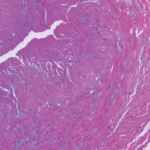Inasmuch as giant cells are seen in perhaps only one-half of biopsies from patients with “giant cell arteritis,” this descriptor is also inaccurate. “Temporal arteritis” is no better, in that arteritic involvement of extracranial arteries is increasingly recognized—indeed, subclinical inflammation of the aorta in GCA may be virtually invariable. A final nosologic vagary is the rubric of “large vessel vasculitis.” GCA is so categorized because it can involve of the aorta and great vessels, and because its histopathology shares similarities with other vasculitides of medium and large arteries, especially Takayasu arteritis. But it is actually the targeting of the tiny muscular arteries of the external carotid artery, of which the superficial temporal artery is a branch—about 0.8 mm in its normal diameter—that results in many of the characteristic symptoms of GCA.
PMR: Treatment Needs a Clinician, Not a Logician
However misleading the name, the clinical presentation of PMR is often immediately appreciated. Many clinicians will recognize a message from their front office to the effect that, “Mrs. A’s daughter called to ask if there is any way her mother’s appointment can be moved up—says that for the past two weeks she is so stiff she can hardly get out of bed in the morning.” Though the onset of the symptoms of PMR may be subacute, more often than not it is abrupt, occasionally startlingly so—patients have told me they went to bed feeling good, but awakened in the morning as though run over by the proverbial truck. The rapid onset of symptoms suggests the possibility of an exposure, particularly to an infectious agent, but the search for evidence of such a pathogen in PMR has been, to date, unrevealing. I have also been struck by what seems to be a curiously frequent reference to unusual physical activity just prior to the onset of symptoms of PMR—though I acknowledge the common penchant of patients to ascribe any musculoskeletal symptoms to prior trauma or exertion.
The ferocious quality of the gel phenomenon in PMR is also distinctive. Though all systemic rheumatic diseases with synovitis are marked by gelling with inactivity, this symptom is particularly prominent in patients with PMR. Waking up at night with the mere act of rolling over in bed, needing help from a spouse with morning activities of daily living, especially with upper- and lower-extremity dressing, trouble transferring out of a car seat after a forty-five-minute ride—all testify to the potency of such gelling.



